Tudor and
Elizabethan Coifs
What is a Coif? | Pictures of Coifs
How to Make an Elizabethan Coif
What is a Coif?
Head coverings during the 16th century ranged from the simple to the
complex. The simplest, which was worn throughout the 16th century and
well into the 17th, was the "coif".
The coif is, quite simply, a close-fitting cap made of a light fabric,
usually white or naturally-coloured linen (or silk, for the nobility). It
was worn for reasons headwear has been worn for centuries--warmth,
protection from the elements, and to keep hair out of the face--but it's
most important functions during Elizabethan times were
conferring respectability upon a woman, and,
for more skilled and affluent people, for decoration.
Womens' Coifs, 1500 to 1550
The coif, in one permutation or another, was one of the most common pieces
of headwear
worn by women (and sometimes by men, as well) throughout the 16th century;
it appears in
many paintings of both nobility and the common folk.
Actual examples of Tudor coifs, however, are hard to find. It is likely
that a
coif or close-fitting cap of some sort was worn underneath the heavy and
concealing veils and english gable hoods of the 1520s and 30s and the
lighter french hoods that followed them, but all that would
show of a coif worn underneath a hood or veil would be the front edge. It
is very difficult and sometimes impossible to tell whether or not the
ruffled border of a gable or french hood is attached to the hood or is the
edging of a coif worn underneath. As almost all female portraits of the
time show the woman wearing a hood of
some kind, there is far less
iconographical evidence to go on then exists during the latter half of the
century.
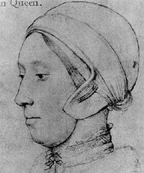 The only
clear depictions of a Tudor coif appear in some sketches by Hans Holbein
drawn in the 1530s, one of Anne Boleyn herself. (see picture to the
right.) The front edge is far back on the crown, with tabs on either side
coming forward past the jawline. The front edge is also wired with a heavy
wire, presumably to keep its shape and to help keep it on the head.
The only
clear depictions of a Tudor coif appear in some sketches by Hans Holbein
drawn in the 1530s, one of Anne Boleyn herself. (see picture to the
right.) The front edge is far back on the crown, with tabs on either side
coming forward past the jawline. The front edge is also wired with a heavy
wire, presumably to keep its shape and to help keep it on the head.
The line of the coif follows quite closely the line of the gable and
transitional hoods worn at the time, a good indication that this coif
was worn underneath a hood as well as by itself.
The coif seems to conform quite smoothly to the head, with no bump at the
crown to signify a bun; Anne's hair was either braided and crossed over
her head somehow, or was fastened at the base of her neck. There are no
gathers at the crown like those which appear in coifs of the late 1590s
and early 1600s. This coif appears to have been shaped with
a vertical seam running down the back center, rather than by gathers at
the nape of the neck.
A strip is wrapped around the coif and knotted at the base of the
neck. Its purpose is unknown; it could be helping to keep the coif more
securely on the head, or help support whatever hood was worn over the coif
so that it didn't slip back. Perhaps it was worn for warmth, or was
simply a fashionable decoration.
There is also another head covering
worn under the coif, visible along the front ed, which looks to be a
band of fabric holding back hair.
In addition,
two (metal?) clips are seen on either side of the coif. It looks like the
edge of the band wrapped around the coif has been slipped underneath one
these clips, perhaps to hold it in place. Aside from this, their purpose
is a mystery. One possible use for the clips could be to aid in keeping
an English hood on the head; straps sewn onto the underside of the
cheekpieces of the hood, when slipped underneath these clips, would keep
the hood on quite firmly (and invisibly.)
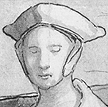 Another of Holbein's sketches portrays a woman wearing a more
loosely-fitting and enveloping coif. It has an wired front identical in
shape to Anne Boleyn's, but comes down farther along the brow and covers
more of the cheek.
Another of Holbein's sketches portrays a woman wearing a more
loosely-fitting and enveloping coif. It has an wired front identical in
shape to Anne Boleyn's, but comes down farther along the brow and covers
more of the cheek.
Coifs, 1570
As the century
progressed, English and French hoods became smaller and more dainty until
they hardly covered a woman's hair at all. A young gentlewoman in the late 1560s, would often wear a french
hood-type headdress placed daintily back on her head, allowing her to show
off the bouffant rolls at her brow which were becoming more popular at
this time. She could choose to wear many other items of headwear as well, among them flat hats, tall hats, pillbox shaped hats, veils, and a variety of other decorative "billiments" perched atop a lady's coiffure. Although
respectable women still had their hair "covered", albeit by nothing more
than a small caul and transparent veil, a woman's hair began to be
considered an asset to be displayed rather than something to be hidden
away beneath a bulky hood. Queen Elizabeth's pride in her red hair had
something to do with this; many women would frizz, bleach and dye their
hair to approximate the Queen's curly red locks.
As headwear became more revealing, coifs became more and more visible--and
more and more popular as a fashionable item of headwear, especially among
the middle classes and working women for whom the tall hats, decorated
caps and wired, transparent veils worn by the gentry were not
practical. Unfortunately, few pictures were drawn or painted of the
English bourgeoisie or servants, and so it is not until 1570
that we find a portrait which shows a coif
of this time in detail.
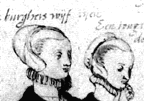 A sketch of London Gentlewomen, drawn in 1570 by Flemish artist Lucas de
Heere, is one of the best examples we have of coifs worn during this
decade. This picture also illustrates the variety in coif styles and
headcoverings to be found in one place and one moment in time.
A sketch of London Gentlewomen, drawn in 1570 by Flemish artist Lucas de
Heere, is one of the best examples we have of coifs worn during this
decade. This picture also illustrates the variety in coif styles and
headcoverings to be found in one place and one moment in time.
Although forty years later than the coifs sketched by Holbein,
these do have some similarities to the coif worn by Boleyn. The front top
rests far back on the crown, while the sides curve far forward along the
jawbone. The fronts are obviously wired, which must help them to stay on
a lady's head. The profile is much rounder than the square shape of the
Tudor coifs shown above, however; and there is another coif or headpiece
worn underneath the outer coif, which comes quite far foward along the
crown of the head and then curves back in a sillhouette quite similar to
that of the late Elizabethan coif. The backs
of these coifs are not seen, but one can postulate that it is shaped by a
seam running down the back of the head and/or gathered at the base of the
neck.
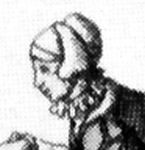 A sketch of London washerwomen created at this time, a detail of which is shown to the left, reveals coifs very
similar to that worn by the women in the back of Heere's painting. These
are close fitting around the sides of the head with the top far back
towards the crown where it meets a gathered circle sewn on the back. A
band of fabric, or under-cap of some kind, is worn underneath this coif, similar to that worn by the Englishwomen in de Heere's sketch. Whether it is worn
as protection for the hair or to give the coif something to be fastened
too.
A sketch of London washerwomen created at this time, a detail of which is shown to the left, reveals coifs very
similar to that worn by the women in the back of Heere's painting. These
are close fitting around the sides of the head with the top far back
towards the crown where it meets a gathered circle sewn on the back. A
band of fabric, or under-cap of some kind, is worn underneath this coif, similar to that worn by the Englishwomen in de Heere's sketch. Whether it is worn
as protection for the hair or to give the coif something to be fastened
too.
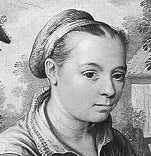 The coifs worn by these washerwomen are somewhat similar to that worn by a
vegetable seller in a Flemish painting by Beuckelaer dated to 1573, shown to the right. The woman in this
picture also wears a coif consisting of a gathered circle at the back of
her head, but it is fastened to a narrow band rather than to
two sidepieces coming forward to the jaw, like the London washerwomen were
wearing, or to a wired close-fitting coif two side points, like
the Englishwoman in de Heere's sketch is wearing. This flemish coif is
seated far back on the woman's head; in fact, I don't
know how she kept the coif on at all, unless the painter is indulging in
a bit of artistic license. I myself use a stretchy comb sewn to the
inside of the
band to keep this kind of coif, which is sometimes referred to as an
"Italian coif", secure and in place.
The coifs worn by these washerwomen are somewhat similar to that worn by a
vegetable seller in a Flemish painting by Beuckelaer dated to 1573, shown to the right. The woman in this
picture also wears a coif consisting of a gathered circle at the back of
her head, but it is fastened to a narrow band rather than to
two sidepieces coming forward to the jaw, like the London washerwomen were
wearing, or to a wired close-fitting coif two side points, like
the Englishwoman in de Heere's sketch is wearing. This flemish coif is
seated far back on the woman's head; in fact, I don't
know how she kept the coif on at all, unless the painter is indulging in
a bit of artistic license. I myself use a stretchy comb sewn to the
inside of the
band to keep this kind of coif, which is sometimes referred to as an
"Italian coif", secure and in place.
The two details from additional Flemish paintings, to the right, show
women wearing something vaguely similar to the italian coif above:
a dark brown, slightly puffed circle of fabric is on the back of the
woman's head, with a length of hair, wrapped with a ribbon, wound
around the base of the "coif" to keep it in place.
The second woman is wearing something which, though hard to make out,
could also be a small, round coif attached to a band. The bottom of the
coif looks rather flat, which suggests that it is cut differently then the
white one shown in beucklayer's painting.
Coifs, 1600
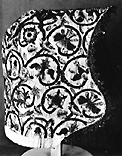 Today, there are far more extant samples of early 17th century coifs
than there are 16th century. Therefore, we have a greater knowledge of the
material, construction and decoration used for these head-dresses than we
have for the coifs worn during King Henry's time and Queen Elizabeth's
earlier reign.
All of the coifs we have which date from 1590-1620 are strikingly similar,
almost identical, in their makeup.
They were rectangular, with the fold of the
fabric going around the back of the head and the seam running along the
top of the head. The bottom of the coif was gathered and tied at the back
of the neck, and the front edge came to a point at the center forehead,
curved back coming down the side of the head, and curved forward again
near the jawline to a blunt, rounded point.
Today, there are far more extant samples of early 17th century coifs
than there are 16th century. Therefore, we have a greater knowledge of the
material, construction and decoration used for these head-dresses than we
have for the coifs worn during King Henry's time and Queen Elizabeth's
earlier reign.
All of the coifs we have which date from 1590-1620 are strikingly similar,
almost identical, in their makeup.
They were rectangular, with the fold of the
fabric going around the back of the head and the seam running along the
top of the head. The bottom of the coif was gathered and tied at the back
of the neck, and the front edge came to a point at the center forehead,
curved back coming down the side of the head, and curved forward again
near the jawline to a blunt, rounded point. The excess material at the
crown of the head was gathered tightly together and stitched down.
The front edge was often decorated with bobbin lace, fancy braid, or other
decorative elements. All of the surviving coifs of this time are
elaborately decorated. This item of headwear was used
an excuse to show off a needleworker's talent; many
surviving coifs are completely embroidered, often with
Blackwork
Embroidery.The front edge was often trimmed with bobbin lace, braid, or some other
decorative
element; if
worn under another headdress, this front edge was
often the only part of the coif that showed. This beautiful decoration may have been one of the reasons
that so many beautiful specimiens of these coifs still survive.
The excess material at the
crown of the head was gathered tightly together and stitched down.
The front edge was often decorated with bobbin lace, fancy braid, or other
decorative elements. All of the surviving coifs of this time are
elaborately decorated. This item of headwear was used
an excuse to show off a needleworker's talent; many
surviving coifs are completely embroidered, often with
Blackwork
Embroidery.The front edge was often trimmed with bobbin lace, braid, or some other
decorative
element; if
worn under another headdress, this front edge was
often the only part of the coif that showed. This beautiful decoration may have been one of the reasons
that so many beautiful specimiens of these coifs still survive.
Pictures of Coifs
The Coif Gallery Has examples of
coifs and coif embroidery techniques from a
number of embroidery and historical costume collections.
You can also check out a Modern
Reproduction of a period coif, complete with blackwork embroidery,
notes and documentation.
Paula Kelly has also created a
Coif embroidered in gold and polychrome silk.
Constructing an Elizabethan Coif
Home
 The only
clear depictions of a Tudor coif appear in some sketches by Hans Holbein
drawn in the 1530s, one of Anne Boleyn herself. (see picture to the
right.) The front edge is far back on the crown, with tabs on either side
coming forward past the jawline. The front edge is also wired with a heavy
wire, presumably to keep its shape and to help keep it on the head.
The only
clear depictions of a Tudor coif appear in some sketches by Hans Holbein
drawn in the 1530s, one of Anne Boleyn herself. (see picture to the
right.) The front edge is far back on the crown, with tabs on either side
coming forward past the jawline. The front edge is also wired with a heavy
wire, presumably to keep its shape and to help keep it on the head.
 Another of Holbein's sketches portrays a woman wearing a more
loosely-fitting and enveloping coif. It has an wired front identical in
shape to Anne Boleyn's, but comes down farther along the brow and covers
more of the cheek.
Another of Holbein's sketches portrays a woman wearing a more
loosely-fitting and enveloping coif. It has an wired front identical in
shape to Anne Boleyn's, but comes down farther along the brow and covers
more of the cheek. 
 A sketch of London washerwomen created at this time, a detail of which is shown to the left, reveals coifs very
similar to that worn by the women in the back of Heere's painting. These
are close fitting around the sides of the head with the top far back
towards the crown where it meets a gathered circle sewn on the back. A
band of fabric, or under-cap of some kind, is worn underneath this coif, similar to that worn by the Englishwomen in de Heere's sketch. Whether it is worn
as protection for the hair or to give the coif something to be fastened
too.
A sketch of London washerwomen created at this time, a detail of which is shown to the left, reveals coifs very
similar to that worn by the women in the back of Heere's painting. These
are close fitting around the sides of the head with the top far back
towards the crown where it meets a gathered circle sewn on the back. A
band of fabric, or under-cap of some kind, is worn underneath this coif, similar to that worn by the Englishwomen in de Heere's sketch. Whether it is worn
as protection for the hair or to give the coif something to be fastened
too.

 Today, there are far more extant samples of early 17th century coifs
than there are 16th century. Therefore, we have a greater knowledge of the
material, construction and decoration used for these head-dresses than we
have for the coifs worn during King Henry's time and Queen Elizabeth's
earlier reign.
All of the coifs we have which date from 1590-1620 are strikingly similar,
almost identical, in their makeup.
They were rectangular, with the fold of the
fabric going around the back of the head and the seam running along the
top of the head. The bottom of the coif was gathered and tied at the back
of the neck, and the front edge came to a point at the center forehead,
curved back coming down the side of the head, and curved forward again
near the jawline to a blunt, rounded point.
Today, there are far more extant samples of early 17th century coifs
than there are 16th century. Therefore, we have a greater knowledge of the
material, construction and decoration used for these head-dresses than we
have for the coifs worn during King Henry's time and Queen Elizabeth's
earlier reign.
All of the coifs we have which date from 1590-1620 are strikingly similar,
almost identical, in their makeup.
They were rectangular, with the fold of the
fabric going around the back of the head and the seam running along the
top of the head. The bottom of the coif was gathered and tied at the back
of the neck, and the front edge came to a point at the center forehead,
curved back coming down the side of the head, and curved forward again
near the jawline to a blunt, rounded point. The excess material at the
crown of the head was gathered tightly together and stitched down.
The front edge was often decorated with bobbin lace, fancy braid, or other
decorative elements. All of the surviving coifs of this time are
elaborately decorated. This item of headwear was used
an excuse to show off a needleworker's talent; many
surviving coifs are completely embroidered, often with
Blackwork
Embroidery.The front edge was often trimmed with bobbin lace, braid, or some other
decorative
element; if
worn under another headdress, this front edge was
often the only part of the coif that showed. This beautiful decoration may have been one of the reasons
that so many beautiful specimiens of these coifs still survive.
The excess material at the
crown of the head was gathered tightly together and stitched down.
The front edge was often decorated with bobbin lace, fancy braid, or other
decorative elements. All of the surviving coifs of this time are
elaborately decorated. This item of headwear was used
an excuse to show off a needleworker's talent; many
surviving coifs are completely embroidered, often with
Blackwork
Embroidery.The front edge was often trimmed with bobbin lace, braid, or some other
decorative
element; if
worn under another headdress, this front edge was
often the only part of the coif that showed. This beautiful decoration may have been one of the reasons
that so many beautiful specimiens of these coifs still survive.